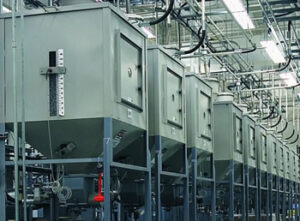In the dynamic world of agriculture, efficiency and productivity are paramount. Farms, regardless of their size or specialization, rely on a multitude of equipment and systems to streamline operations and optimize yields. One such crucial component often employed in modern farming practices is the surge bin. Acting as a buffer between different stages of production, surge bins play a pivotal role in ensuring smooth operations and maximizing the efficiency of farm processes.
This comprehensive guide delves into the significance of surge bins in agricultural settings, exploring their functions, benefits, and diverse applications across various farming operations.
Understanding Surge Bins
What Are Surge Bins?
Surge bins, also known as surge hoppers or day bins, are storage containers designed to temporarily hold bulk materials. These bins are strategically placed within the production line to manage fluctuations in material flow. They serve as intermediate storage units, allowing for a consistent feed of materials to downstream processes while accommodating variations in input rates.
Construction and Design
Surge bins are constructed from various materials, including steel, concrete, or composite materials, based on the specific requirements of the farm and the nature of the materials being handled. Their design considers factors such as capacity, flow characteristics, and the nature of the materials to be stored.
These bins often feature sloped sides to facilitate the smooth flow of materials, ensuring efficient discharge without clogging or blockages. Additionally, they may incorporate mechanisms such as vibrators or agitators to prevent material bridging or rat-holing, ensuring a steady flow of contents.
Functionality in Farm Operations
Handling Harvest Surges
During peak harvest seasons, farms experience surges in produce or raw materials. Surge bins play a vital role in managing these fluctuations by providing temporary storage. This prevents bottlenecks in the production line, allowing continuous processing without interruptions.
Buffering Material Flow
In various agricultural processes, such as milling, drying, or mixing feeds, surge bins act as buffers, absorbing variations in material flow rates. This ensures a steady supply to downstream equipment, optimizing their efficiency and reducing downtime.
Enhancing Efficiency in Livestock Feeding
For livestock farms, surge bins facilitate the storage and controlled dispensing of feed. They enable automated feeding systems to function smoothly by ensuring a consistent supply of feed, contributing to better livestock management and health.
Applications Across Farming Operations
Grain Handling
In grain handling facilities, surge bins are indispensable. They receive grain from harvesters or transport vehicles, allowing for continuous unloading even during peak periods. This ensures a constant supply of grain to dryers or processing units, preventing delays and optimizing throughput.
Feed Manufacturing
Surge bins are integral to feed manufacturing processes. They store and regulate the flow of raw materials like grains, vitamins, and minerals. By maintaining a steady supply to mixers and pelletizers, surge bins contribute to consistent feed quality and efficient production.
Silage Production
For farms involved in silage production, surge bins manage the flow of chopped forage material. They allow for controlled filling of silage storage structures, ensuring uniform compaction and quality throughout the silage mass.
Dairy Operations
Dairy farms benefit from surge bins by efficiently handling feed for livestock. These bins enable the precise dispensing of a balanced diet, contributing to optimal milk production and herd health.
Benefits of Surge Bins in Farming
Increased Operational Efficiency
Surge bins streamline material flow, reducing interruptions and optimizing the utilization of downstream equipment. This translates to enhanced productivity and reduced idle time, ultimately improving the overall efficiency of farm operations.
Minimized Wastage
By mitigating fluctuations in material flow, surge bins minimize spillage and wastage that may occur due to abrupt surges or interruptions in production.
Improved Equipment Longevity
Consistent and controlled material flow facilitated by surge bins helps in reducing wear and tear on equipment downstream. This leads to prolonged equipment lifespan and decreased maintenance costs.
Conclusion
In the ever-evolving landscape of modern agriculture, surge bins emerge as indispensable components, fostering efficiency, and reliability within farm operations. These versatile storage units offer solutions to manage fluctuations in material flow, ensuring seamless production processes across various agricultural sectors.
From handling harvest surges to optimizing feed manufacturing and silage production, surge bins play a pivotal role in maintaining consistent operations and maximizing yields. Their ability to buffer and regulate material flow not only enhances productivity but also contributes to resource conservation and cost-effectiveness.
As farming practices continue to evolve, surge bins stand as a testament to innovation in agricultural technology, enabling farmers to navigate the challenges of fluctuating material flow with precision and efficiency.


